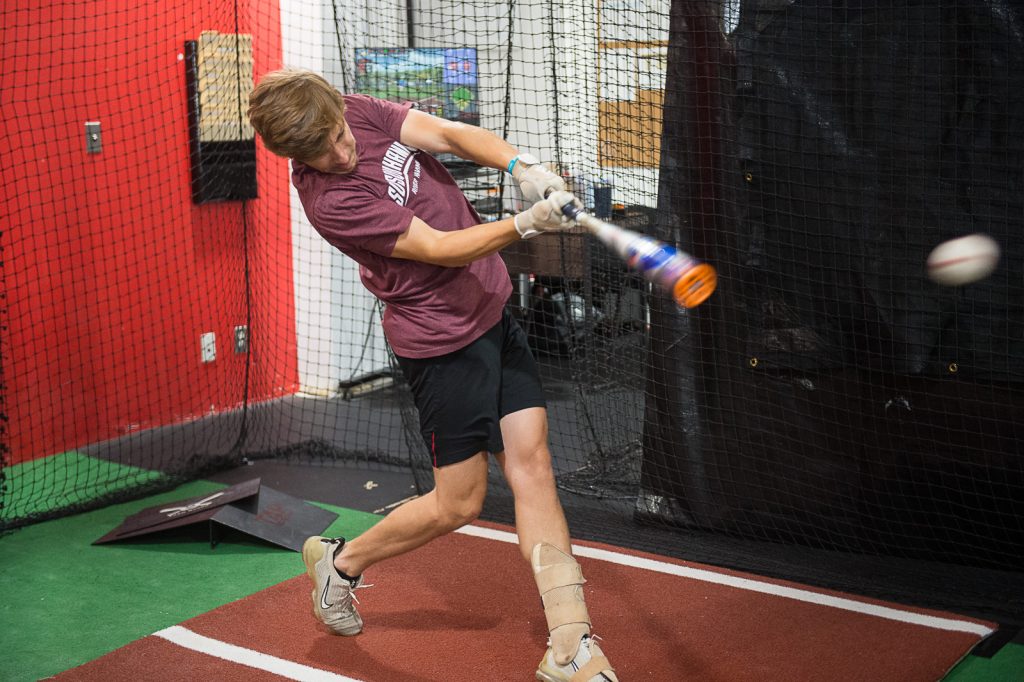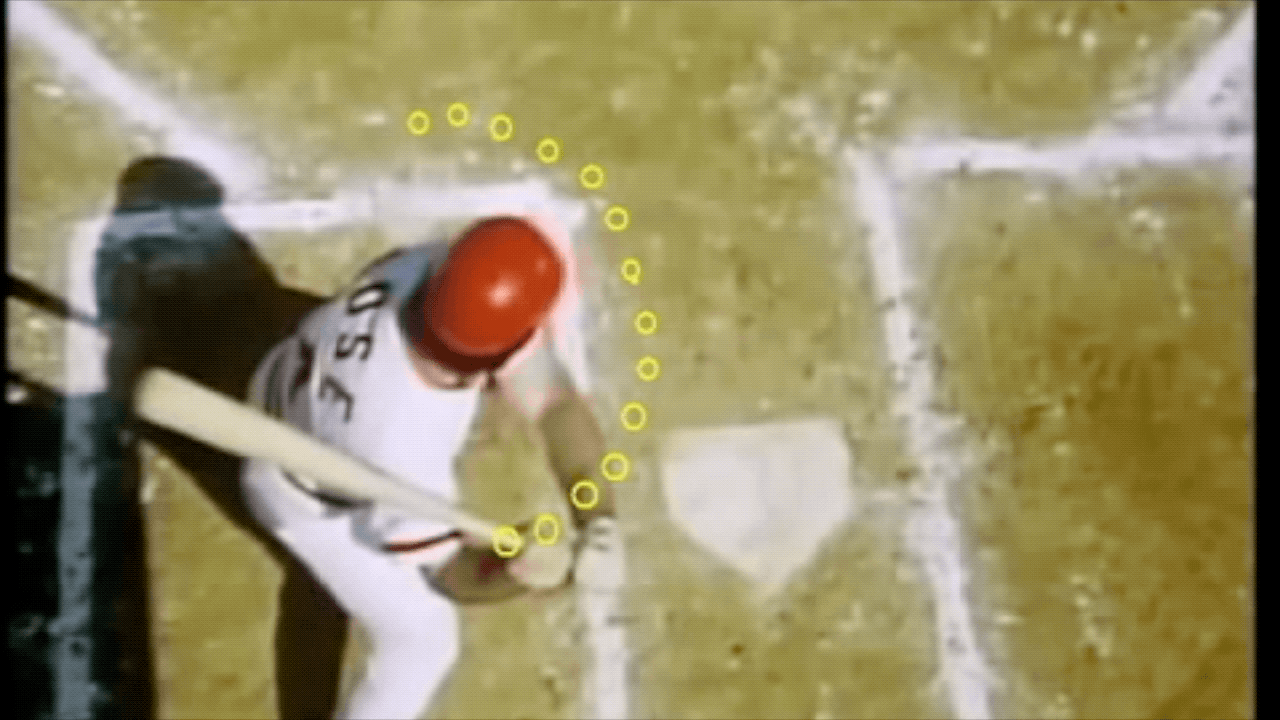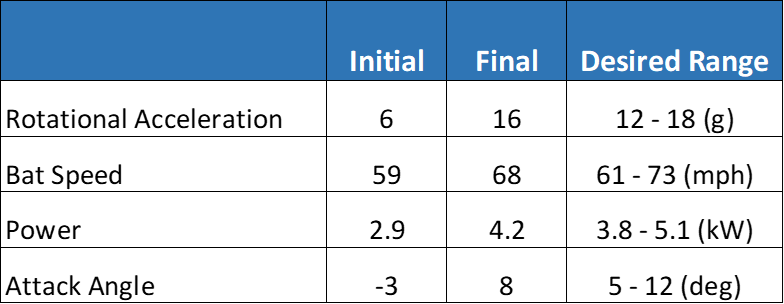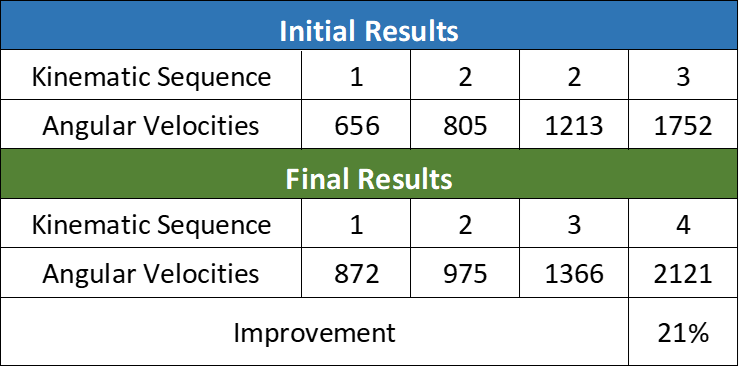
Tyler Hmielewski, infielder for Susquehanna University, joined us last summer for the 3-month college hitting development program. His objectives were to improve his overall performance at the plate by becoming more explosive while improving his adjustability to help make more consistent contact for extra bases. In June, Tyler started the program at 5’9” and 148 bs. His Rotational Acceleration was 6 g(s) and his bat speed was 59 mph. By the end of the summer, Tyler weighed in at 162 lbs. (a 14 lbs. increase), his Rotation Acceleration had improved to 16 g(s) and bat speed was up to 68 mph.
How did he do it?
Our college summer program is only 3 months long, so we have a limited amount of time to make a real impact. So, the best way to do this is to focus on the athlete’s lowest hanging fruit. In Tyler’s case, three areas stood out from his initial assessment:
-
- Increasing his lean muscle mass / upper body power
- Improving his load (hitting mechanics)
- Improving his overall swing metrics
Let’s review each with some specificity…
Increasing Tyler’s Lean Muscle Mass / Upper Body Power
At 5’9”, we’d like to see Tyler at a minimum of 172.5 lbs. while carrying < 15% body fat. Initially, Tyler clocked in with a lean 6% Body Fat, but at only 148 lbs. Consequently, his lowest hanging fruit was in the weight room, adding more muscle to become stronger and more explosive.
His strength program consisted of two different phases:
-
- Weeks 1-6: Hypertrophy Phase (add lean muscle mass) – First a hypertrophy phase to build more cross-sectional muscle fiber with the intention of getting him to put on more size and strength
- Weeks 7-12: Power (become more explosive) – Second, to get him fast producing that strength, as in more explosive. Thus, the latter half of his training program focused on power, especially in his upper body. This is where extensive work with the proteus motion was key, helping him to move lighter loads at faster speeds.
By summer’s end Tyler had added 14 lbs. of lean muscle mass, increasing his weight to 164 lbs. Although he can still add additional muscle mass on his frame, this is a significant improvement during the short summer season, and his swing metrics will show the improvement as we get later in this article. Below is a summary of Tyler’s main lifts and improvements during the summer in the weight room:
-
- Deadlift 1RM – 312 -> 362 lbs.
- Single Leg Squat 1RM – N/A -> 89 lbs.
- Bench Press – 198 -> 252 lbs.
Towards the middle of the summer, Tyler’s strength levels for his size reached a level in which we deem “strong enough” to begin working on the velocity side of the power equation.
Improving Tyler’s Load (hitting mechanics)
A review of Tyler’s hitting mechanics highlighted a number of areas early in his swing related to how he loads that we need to address, including:
-
- Excessive Negative Weight Shift – This is an excessive lower body lateral movement “away” from the pitcher during the negative move that forces the weight to the outside of the back foot. This throws off the timing of the lower body.
- Rear Hip Load – Regardless of stance style, the swing begins and fires in a spring around the rear hip socket. Knees should be inside the ankles from stance and continue throughout the stride in order to carry tension in the lower body throughout the stride to eventually be released into the upper body.
- Maintaining Center of Mass – Creating and maintaining the body’s center of mass relative to the base of support from start to finish. The head/torso column needs to remain vertical, centered between the feet. This is also known as “Loss of Posture”. Many times, this is also referred to as “collapsing the back side” This can make it difficult for players to stop their linear move and transition fully into rotation.
- Maintaining a Linear Momentum – Lack of linear momentum describes an athlete who does not have a good weight transfer to the front side. This is usually caused by rotating/spinning or “squishing the bug” around the back hip rather than the front through proper blocking. This can also cause the hitter to hit in a small zone.
We believed that getting Tyler to load better and maintain his center of mass will ultimately result in improved performance down the chain in his swing, from an improved Attack Angle to higher Bat Speeds and increased power.
We addressed these issues with movement drills to help with his proprioception (the body’s ability to sense movement in time and space), spending a majority of our time implementing a coil drill with the assistance of the Core Velocity Belt.
Improving Tyler’s Swing Metrics
As a part of our initial assessment, we utilize a Blast Motion sensor. Blast is a great tool that helps evaluate swing metrics. Tyler’s Blast metrics highlighted a few areas that we needed to address, including:
-
- Rotational Acceleration: 6g (target range 12-18 g) – An appropriate amount of RA is critical for adjustability at the plate, especially at higher pitch speed. Most misunderstand when this measurement actually takes place. So here is a video to illustrate.

-
- Bat Speed: 59 mph (target range 61-73 mph) – Measure six inches from the top of the bat, this measurement is exactly what it says it is and the more the merrier.
- Power: 2.9 kW (target range 3.8-5.1 kW) – Power at contact is what drives the ball. If you want to hit for extra bases, you need power.
- Attack Angle: -3 degrees (target range 5-15 degrees) – A slightly upward angle of contact versus the horizontal plane is critical for making good contact. Not only does this help line up the swing with the incoming pitch approach angle, it also allows you to elevate the ball with the maximum amount of force transfer into the baseball.
Although some of these metrics are highly correlated to overall strength and power levels, proper sequencing and an improved load can help all these metrics as well.
Summary Results
Tyler put in a great amount of effort into his craft this summer and the results speak for themselves. In addition to focusing on increasing overall strength and power in the weight room and improving how he loads into his swing, Tyler’s other metrics have also significantly improved this summer.
-
- First up and perhaps most important is his exit velo, which has jumped approximately 5 mph from 87-89 mph to 92 – 94 mph
- Second are his Blast metrics which have improved dramatically, from bat speed and power to rotational acceleration and attack angles

-
- Lastly, it’s important to highlight how Tyler has improved his sequencing and angular velocities up the chain. Increased strength can directly translate to higher angular velocities and ultimately more power at contact which is clearly demonstrated here as Tyler’s power at contact has increased from 2.9 kW to 4.2 kW, a significant improvement. Below is an illustration of a proper Kinematic Sequence using K-Vest, from the hips to the torso, shoulder and ultimately the hands.

-
- Here is a summary of Tyler’s initial and final sequencing and angular velocities.

Great job Tyler, keep up the hard work and best of luck back at school.
By Bahram Shirazi, Nunzio Signore and Andrew Pezzutto
You live too far to train with us in-house at RPP? You can now train with us on a REMOTE basis.


